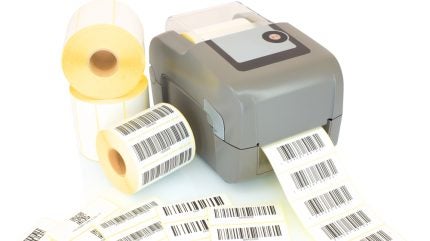
In warehouses, retail environments, healthcare facilities and logistics networks, thermal labels have become the go-to choice for fast, reliable, and cost-effective labelling.
Whether it’s for product barcoding, shipping parcels, or organising files, thermal printing technology offers a streamlined solution with minimal maintenance.

Discover B2B Marketing That Performs
Combine business intelligence and editorial excellence to reach engaged professionals across 36 leading media platforms.
As businesses continue to embrace automation and efficiency, understanding the benefits and applications of thermal labels is increasingly essential.
What are thermal labels and how do they work?
Thermal labels are a type of label designed for use with thermal printers, which operate using either direct thermal or thermal transfer technology. Unlike traditional ink-based printing, thermal printers use heat to create images on specially treated label surfaces.
Direct thermal labels react to heat from the printer’s thermal head, turning black in the heated areas to form text or barcodes.
This method does not require ink, toner or ribbons, making it highly cost-effective for short-term applications such as shipping labels or receipts. However, direct thermal labels are sensitive to heat and light, which can cause them to fade over time.

US Tariffs are shifting - will you react or anticipate?
Don’t let policy changes catch you off guard. Stay proactive with real-time data and expert analysis.
By GlobalDataThermal transfer labels, by contrast, use a heated ribbon to transfer ink onto the label surface, resulting in a more durable image. These labels are ideal for long-term use, especially in outdoor or industrial settings where labels must withstand exposure to chemicals, moisture, or extreme temperatures.
Thermal transfer printing offers a broader range of materials, including polyester and polypropylene, which are particularly suited to asset tagging or high-durability signage.
Understanding the difference between direct thermal and thermal transfer labels is key to choosing the right solution for a particular application. Each has distinct advantages, depending on the required lifespan, environmental exposure, and budget.
Key advantages of using thermal labels
The primary appeal of thermal labels lies in their simplicity and reliability. With fewer moving parts and no ink cartridges to replace, thermal printers require less maintenance than conventional alternatives.
This results in lower operating costs and reduced downtime—critical factors for businesses with high-volume labelling needs.
Thermal labels also provide crisp, high-resolution printing, which is essential for barcode clarity. Poorly printed barcodes can lead to scanning errors and costly delays in the supply chain. With thermal printing, the sharpness and consistency of the label image ensures accurate scanning and seamless integration into inventory systems.
Another significant benefit is speed. Thermal printers are designed for rapid, on-demand label creation, making them suitable for dynamic work environments where efficiency matters.
Whether printing thousands of shipping labels in an e-commerce warehouse or individual patient wristbands in a hospital, thermal labels meet the need for fast turnaround without compromising quality.
Sustainability is an emerging factor in labelling decisions, and thermal labels can support environmentally conscious operations. Direct thermal printing reduces waste by eliminating the need for ink and ribbons, while many thermal label materials are now recyclable or produced from responsibly sourced paper.
Some suppliers also offer BPA-free options, catering to growing consumer and regulatory concerns.
Common uses and applications across industries
Thermal labels have found widespread adoption across multiple sectors due to their versatility and performance. In retail, they are frequently used for shelf-edge labels, pricing, and product identification.
Their compatibility with barcode scanning systems helps streamline inventory control and point-of-sale transactions.
In logistics and transportation, thermal shipping labels are indispensable. Direct thermal labels are often used for parcels and courier packages, while thermal transfer labels are preferred for long-haul freight and pallet tagging due to their enhanced durability.
Healthcare is another area where thermal labels play a vital role. Hospitals and laboratories use them for patient wristbands, specimen tracking, and medication labelling. The clear print quality and resistance to smudging or fading help reduce errors and ensure safety.
Manufacturing and warehousing operations benefit from thermal transfer labels that can withstand exposure to dust, chemicals, and abrasions. These labels are often used for asset tracking, bin labelling, and compliance marking. Given their resilience, they are ideal for harsh environments where paper-based alternatives would quickly degrade.
Even in office settings, thermal labels offer practical solutions for file organisation, mailing, and archiving. Their ease of use, especially with compact desktop printers, has made them popular in both home and professional environments.
The takeaway
From boosting productivity to ensuring reliable data capture, thermal labels provide an enduring solution for labelling across a wide range of industries.
As technology continues to evolve, the core advantages of thermal labels—speed, clarity, and cost-efficiency—remain highly relevant.
For businesses seeking to optimise operations and reduce overheads, investing in the right thermal label system can deliver significant long-term benefits.





